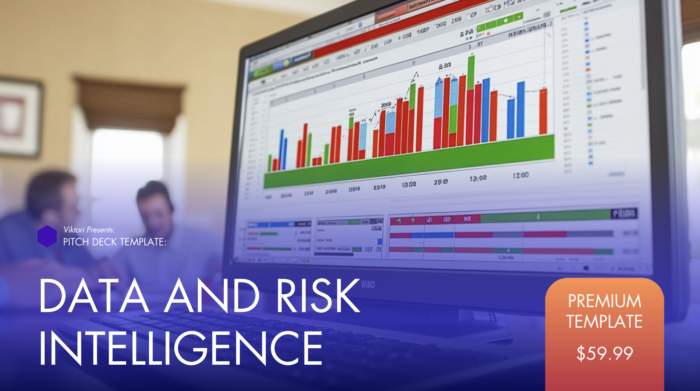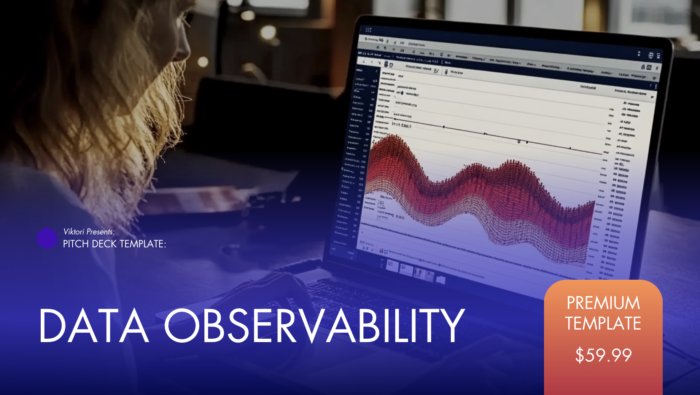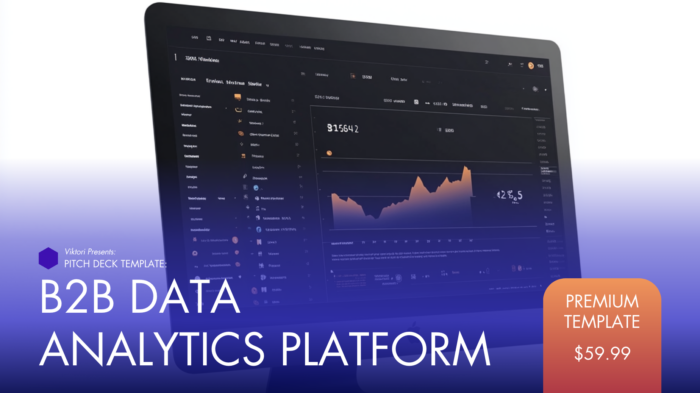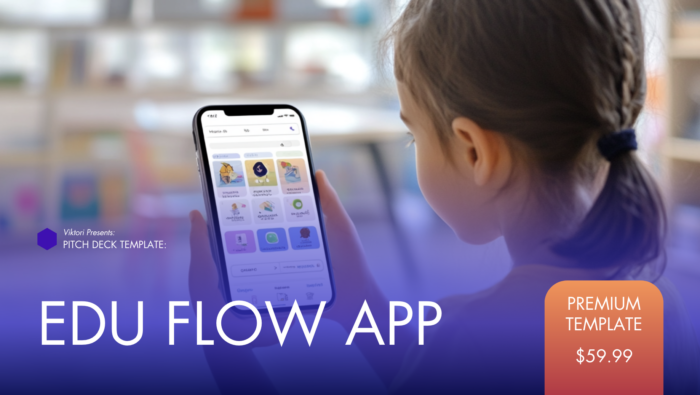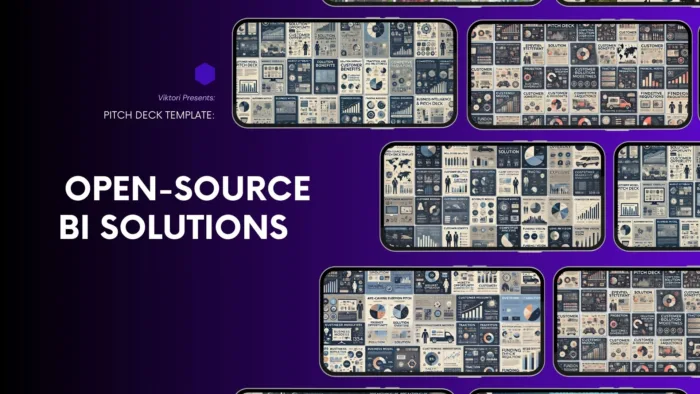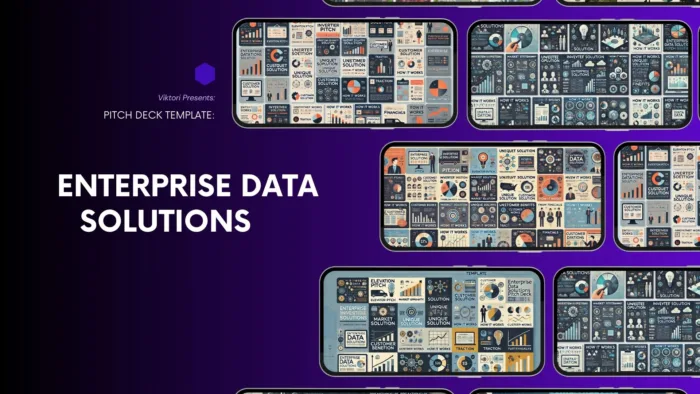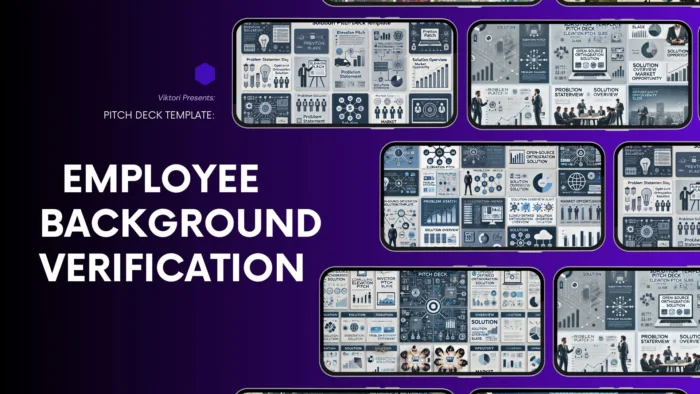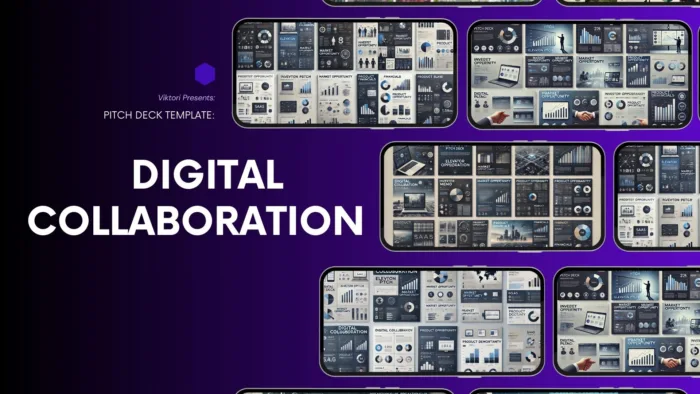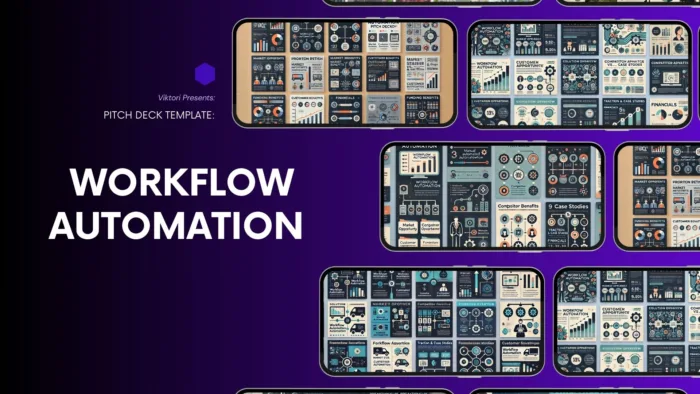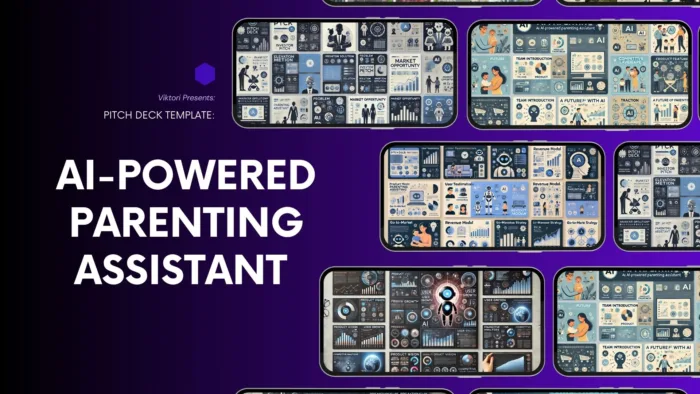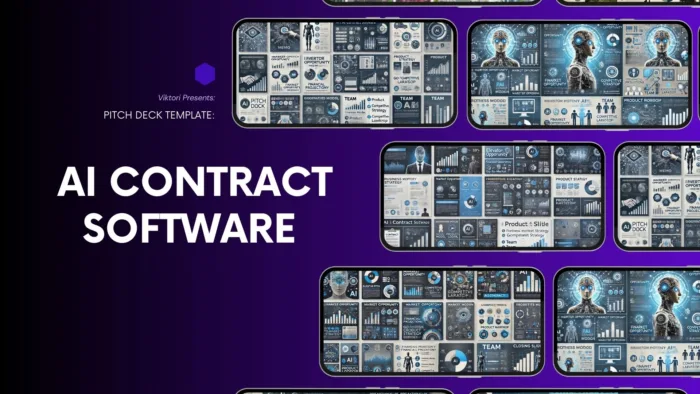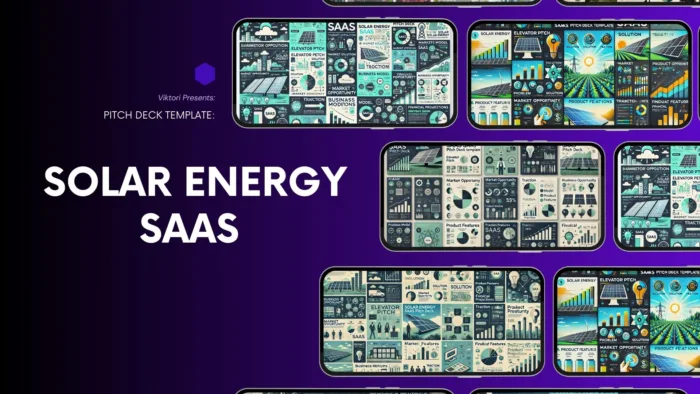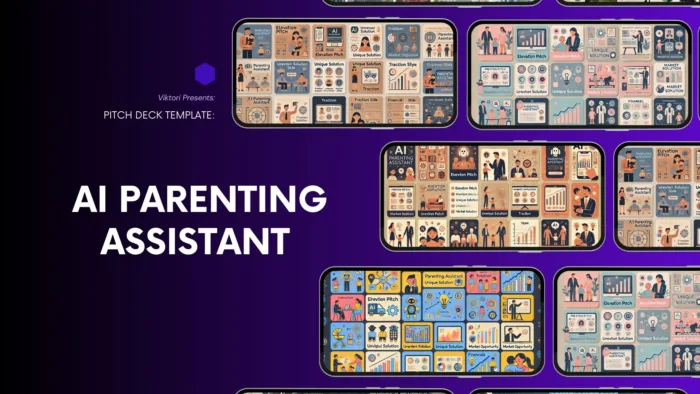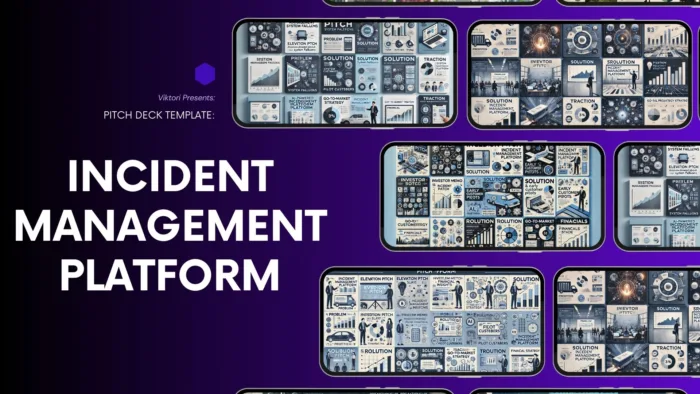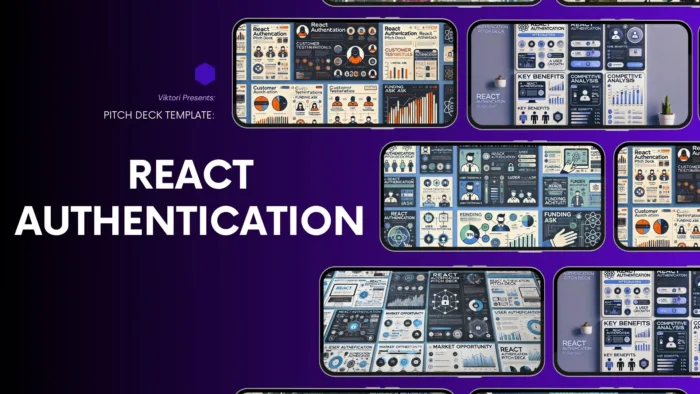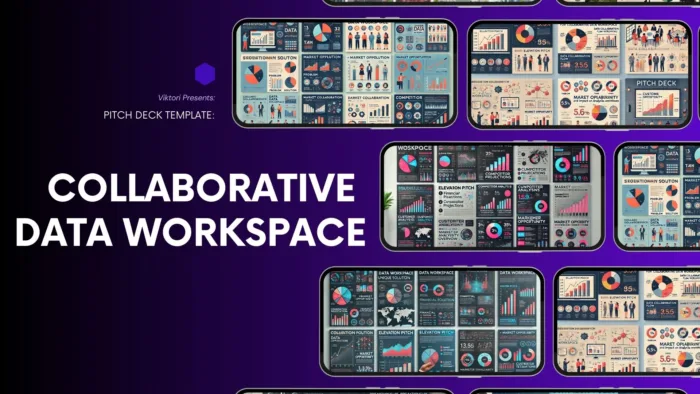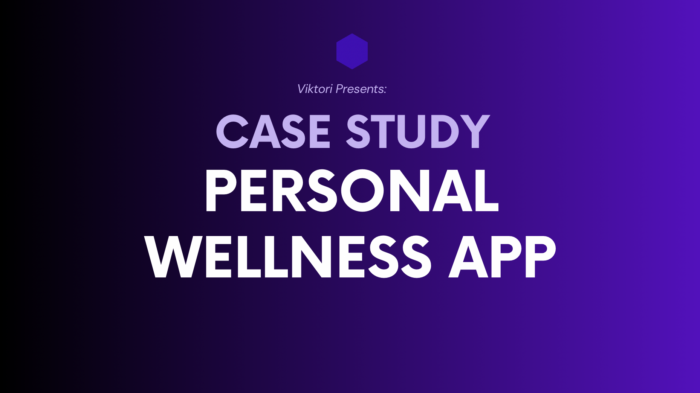Pitching a SaaS to investors nowadays feels like your ex telling you back then that you were the only one, there are just too many. SaaS products have become a standard and so has getting funding for them – and for some founders, investors just don’t give a damn.
I’m Viktor, a pitch deck expert and creative business strategist. Over the past 13 years, I’ve helped businesses secure millions of $ in funding thanks to my approach and I’m sharing it here in this pitch deck guide.
I’ve pitched my own startups and know how frustrating this part can get, particularly when you don’t have the right deck.
With this quick guide, you’ll be able to create a bulletproof SaaS pitch deck, or use my own template, depending on how fast you need to get funded.
Let’s begin.
Just In: Sales Enablement SaaS Pitch Deck Case Study. Find out how we helped SmartCue build an investor ready deck.
Get an investor ready pitch deck that gets you funded and saves over 30 hours of your time.
Join 100s of successful entrepreneurs who’ve transformed their pitch decks by using my hands-off approach, which includes: market research, copy, design, financials, narrative and strategy.
1 week turnaround time and less. Special pricing for early stage companies.
The least you will get on this call is 10 actionable tips & strategies to own that next pitch, worth $599, for free.

What is SaaS Pitch Deck?
A SaaS pitch deck is a visual presentation that aims to convince investors to fund a software as a service (SaaS) company. This type of deck typically includes information about the product or service, the target market, the business model, the marketing strategy, the team, and financial projections.
A SaaS pitch deck aims to showcase the company’s potential and the value it could bring to the market.
How to Build a Successful SaaS Pitch Deck?
Here’s a detailed video explaining how to build a pitch deck for your SaaS
Here’s the deck I created in the video above:
To build a winning pitch deck, first focus on understanding your target audience’s perspective and tailoring your approach accordingly. To help you improve your narrative, check this selection on the best books for pitching. The authors have won billions in $ thanks to their ability to create stories when pitching and are sharing their methods with you.
You’ll also want to make sure that your pitch includes key information, such as an overview of your product, a clear value proposition, and a viable business model.
Visual elements, such as graphs and charts, can help to illustrate important data and increase engagement.
Additionally, anticipate potential objections or questions your audience may have and address them upfront in your pitch.
Finally, practice your pitch to ensure that you can effectively communicate your message with enthusiasm and confidence.
By following these guidelines, you can create a compelling and effective pitch deck that can help you secure funding and grow your business.
What Slides Should You Include in Your SaaS Pitch Deck?
An investor ready SaaS pitch deck includes the following slides:
Slide 1: Title Slide
Formula: Company Name + Clear Value Proposition
Content:
- Logo
- Company Name: [Insert Name]
- Tagline: “The [Product] that [solves this pain point] for [specific audience].”
- Visual: Professional logo, clean design with a captivating image or abstract tech-inspired background.
Slide 2: The Problem
Formula: State the pain clearly + Back it up with relatable data.
Content:
- Header: “The Problem: [Core Issue]”
- Bullet Points:
- Who experiences this problem (target audience).
- Why the problem matters (impact on productivity, costs, etc.).
- A strong statistic or relatable real-world example.
Example: “80% of remote teams report feeling disengaged, leading to $450B annual productivity loss.”
Visual: A clean graphic or icon representing the problem.
Slide 3: The Solution
Formula: Introduce the product as the solution. Keep it simple and clear.
Content:
- Header: “Introducing [Product Name]: The Solution to [Problem].”
- Core Value: One sentence explaining how it solves the pain point.
- Key Benefits (3 concise points):
- Benefit 1: Saves time.
- Benefit 2: Improves productivity.
- Benefit 3: Reduces costs or improves engagement.
Visual: Product screenshot, a short GIF, or an illustrative mockup.
Slide 4: Market Opportunity
Formula: Show the market size and potential for growth.
Content:
- Header: “The Market Opportunity”
- TAM/SAM/SOM Breakdown:
- Total Addressable Market (TAM): $X Billion
- Serviceable Available Market (SAM): $X Billion
- Serviceable Obtainable Market (SOM): $X Million
- Why Now: Highlight trends driving market demand (e.g., remote work, AI adoption, etc.).
Visual: Graph or pie chart to simplify TAM/SAM/SOM.
Slide 5: Product Demo
Formula: Show how it works. Simple, clear, and visual.
Content:
- Header: “How It Works”
- Visual Walkthrough: 3-4 simple steps.
- User signs up.
- Dashboard or main feature (show key actions).
- Value delivered (e.g., results, improved workflow).
Visual: Screenshots, short video, or clean diagram with callouts.
Slide 6: Business Model
Formula: Explain how you make money + pricing tiers.
Content:
- Header: “Our Business Model”
- Monetization Strategy:
- Subscription tiers (e.g., Free, Pro, Enterprise).
- Pricing Example: “$10 per user/month”
- Add-ons or premium features.
Visual: Clean table or icons showing pricing tiers and feature differentiation.
Slide 7: Traction
Formula: Show proof of demand and early wins.
Content:
- Header: “Our Traction So Far”
- Key Metrics:
- Current users: [e.g., 10,000 active users]
- Revenue: [e.g., $50K MRR]
- Customer retention: [e.g., 90% month-over-month]
- Testimonials or case studies.
Visual: Graph showing user or revenue growth, with customer logos or quotes.
Slide 8: Competitive Advantage
Formula: Show how you’re different and better.
Content:
- Header: “Why We Stand Out”
- Competitive Matrix: Compare your product to competitors across features or benefits.
- Key Differentiators:
- What makes your product unique (e.g., faster, cheaper, easier to use).
Visual: Competitor comparison chart or side-by-side feature breakdown.
Slide 9: Go-To-Market Strategy
Formula: Explain how you’ll acquire customers.
Content:
- Header: “Our Go-To-Market Plan”
- Acquisition Channels:
- Organic growth: SEO, content, freemium strategy.
- Paid: Digital ads, partnerships.
- Sales: Direct outreach, referrals.
- Growth Plan: Outline first-year milestones.
Visual: Funnel diagram or roadmap timeline.
Slide 10: Team
Formula: Highlight relevant experience and expertise.
Content:
- Header: “Our Winning Team”
- Founders: Headshots, names, roles, and short achievements.
- Advisors: Key industry experts, if applicable.
Example:
- CEO: 10+ years in SaaS, scaled startups to $10M ARR.
- CTO: Tech lead for successful SaaS exits.
Visual: Professional headshots with titles and one-liners.
Slide 11: Financial Projections
Formula: Show revenue growth, key metrics, and sustainability.
Content:
- Header: “Financial Projections”
- Key Metrics:
- Year 1: $250K ARR
- Year 3: $5M ARR
- Revenue Drivers:
- Customer acquisition rate.
- Monthly/annual subscription growth.
Visual: Bar chart showing revenue milestones over 3-5 years.
Slide 12: The Ask
Formula: State what you need and why it’s a great opportunity.
Content:
- Header: “Join Us on This Journey”
- The Ask:
- “We’re raising $1.5M to accelerate growth, scale marketing, and enhance product development.”
- Use of Funds: Pie chart or clear bullet points.
- 50% Product Development
- 30% Marketing
- 20% Sales and Operations
- Closing Line: “Let’s build the future of [industry] together!”
Visual: Clean, bold text with inspiring imagery or a confident team photo.
The above is is just a simplified pitch deck version developed as part of our entrepreneurship program for graduate studies.
Founders that are serious about getting the funding they need, opt in for a deck has industry specific content, superb narrative and award winning design like these ones below:









I can help you build that deck with my hands-off process in 7 days or less.
Book a free 30 minute call below if you’re serious about getting an investor ready deck, and we’ll discuss your needs in detail. I’ll help you design the deck, write the content, develop the narrative and flesh out the strategy with financials.

We help 15,000+ founders every month create better pitch decks.
Alternatively, get the custom template for just $69,99.As soon as the payment is processed I’ll send over a quick questionnaire and deliver the deck in 24 hours and less.

Follow us on social for the newest templates:
Overall, your pitch deck should be clear, concise, and visually appealing, while effectively conveying your key points and unique selling proposition to potential investors or customers.
What Should Not Be Included in Your SaaS Pitch Deck?
Firstly, don’t include too much text on each slide. Instead, opt for visuals and bullet points to convey your message. Secondly, don’t include irrelevant information about your company, such as the founding story or detailed financial projections.
Thirdly, avoid using industry jargon or buzzwords that may confuse or alienate your audience. Keep the language simple and easy to understand.
Lastly, don’t forget to include a clear and compelling call to action at the end of your pitch deck to encourage potential customers to take action.
What is The Best Way to Design a Precise SaaS Pitch Deck for a Startup?
The first step in the process is clearly identifying the problem the startup aims to solve. A thorough examination of the target market, including the size of the market, the competition, and the potential customer base should follow this.
Once these details have been established, the next step is to highlight the startup’s unique value proposition, such as the innovative technology, the team’s expertise, and the potential ROI for investors. It is important to ensure that the pitch deck is visually appealing, easy to read, and highlights the key points of the project.
By following these steps, startups can create a precise and effective SaaS pitch deck communicating their vision and attracting investors.
Get Your Copy Of The Pitch Deck Template
If you’re pitching a SaaS, you need a strong pitch deck to grab the attention of buyers and investors.
The good news is you don’t have to make decks from scratch. Creating an effective SaaS pitch deck is all about knowing what slides to include. You can find tons of templates on sites like Canva, Slidesgo and Google Slides, but none of them will align with the brand you represent.
What will happen is you’ll need to spend hours adjusting these templates to fit your brand guidelines.
There’s a better way.
My clients have used my written template to craft a stellar SaaS pitch deck in half the time and designed a deck that secured their new funding.
Pitch Deck Examples
Dropbox
Pendo
Intercom
Buffer
Mattermark
Example SaaS Pitch Decks For You To Get Inspired
1. Project Management Pitch Deck Slides Examples
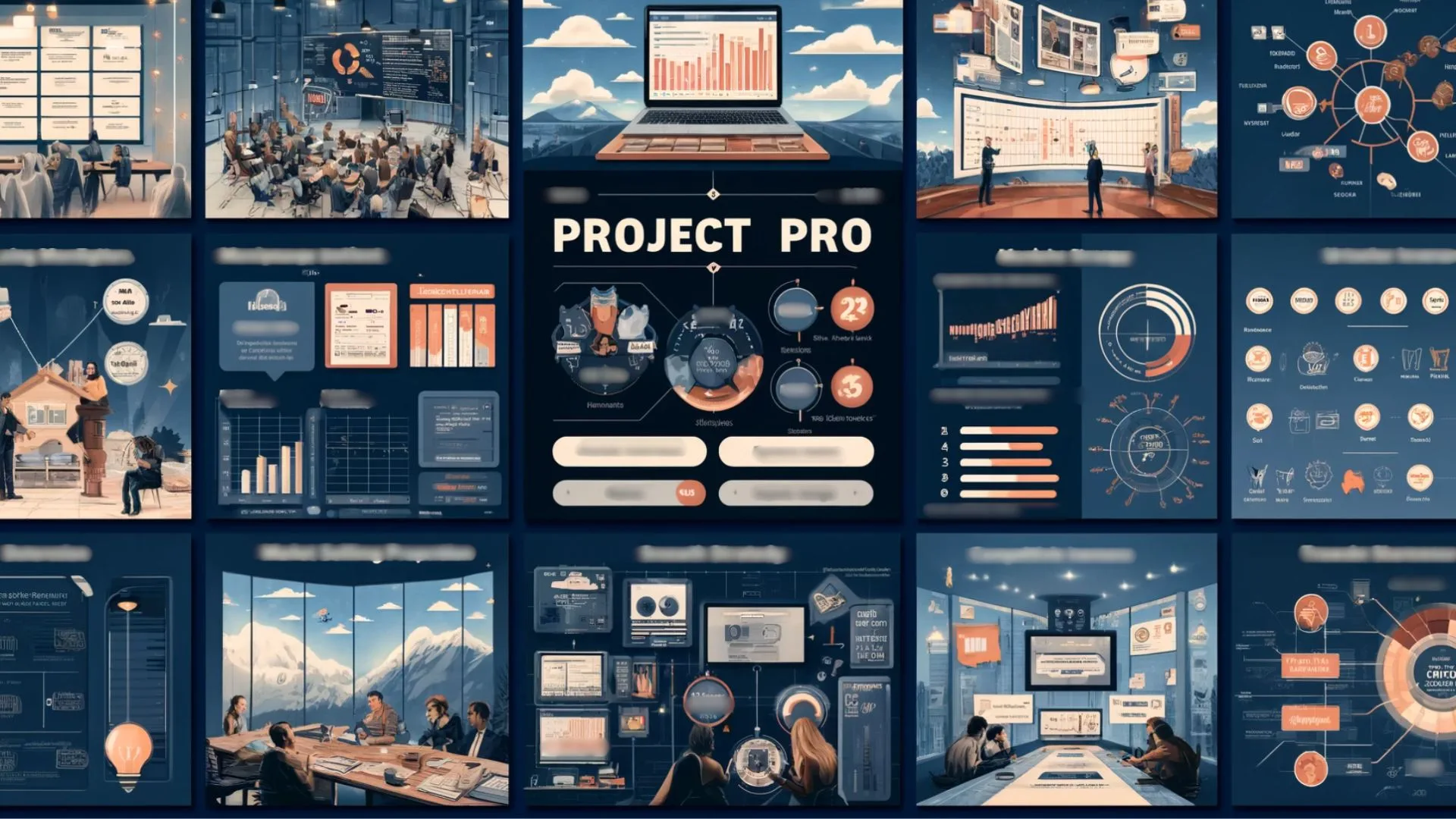
Slide 1: Elevator Pitch Slide
- SaaS Product Name: “ProjectPro”
- Subtitle: “Streamlining Project Management for Efficient Collaboration”
Slide 2: SaaS Concept
- Problem: Inefficient project management processes, lack of collaboration, and difficulty tracking project progress.
- Solution: “ProjectPro” is a comprehensive project management platform that simplifies task management, enhances team collaboration, and provides real-time project tracking.
- Key Features: Task assignment, Gantt chart visualization, team messaging, file sharing, and integrations with popular productivity tools.
Slide 3: Target Audience
- Demographics: Small to medium-sized businesses, remote teams, and project managers seeking a user-friendly project management solution.
- Potential Reach: Projected user base based on market research and targeted marketing strategies.
Slide 4: Unique Selling Proposition (USP)
- USP: “ProjectPro” combines powerful project management features with an intuitive user interface, making it the go-to platform for efficient project execution.
- Competitive Advantage: Seamless team collaboration, robust reporting and analytics, and customizable workflows that adapt to any project.
Slide 5: Monetization Strategy
- Subscription Model: Offer tiered pricing plans based on the number of users, storage space, and additional features.
- Enterprise Solutions: Tailor enterprise-level packages for larger organizations, including custom integrations and dedicated support.
- Premium Support and Training: Provide additional services such as priority support, onboarding assistance, and training programs for a premium fee.
Slide 6: Growth Strategy
- User Acquisition: Outline strategies to attract new users, such as targeted marketing campaigns, content marketing, and partnerships with complementary SaaS platforms.
- User Retention: Detail plans to engage and retain users through product updates, continuous customer support, and user feedback implementation.
Slide 7: Market Potential and Competition
- Market Size: Present market research data on the growth and potential of the project management software market.
- Competitive Landscape: Identify key competitors and highlight how “ProjectPro” differentiates itself through unique features, user experience, and customer support.
Slide 8: Product Demo and User Interface
- Showcase screenshots or a product demo video to provide a visual representation of the platform’s user interface and key features.
- Emphasize the platform’s simplicity, ease of use, and visual appeal.
Slide 9: Security and Data Protection
- Detail the security measures in place to protect user data, including encryption, regular audits, and compliance with data protection regulations.
- Highlight any relevant certifications or partnerships with trusted security providers.
Slide 10: Next Steps
- Call to Action: Schedule a meeting to discuss potential partnerships, investment opportunities, or collaborations with businesses in need of a project management solution.
2. HealthTrack: A Health and Wellness Management Platform
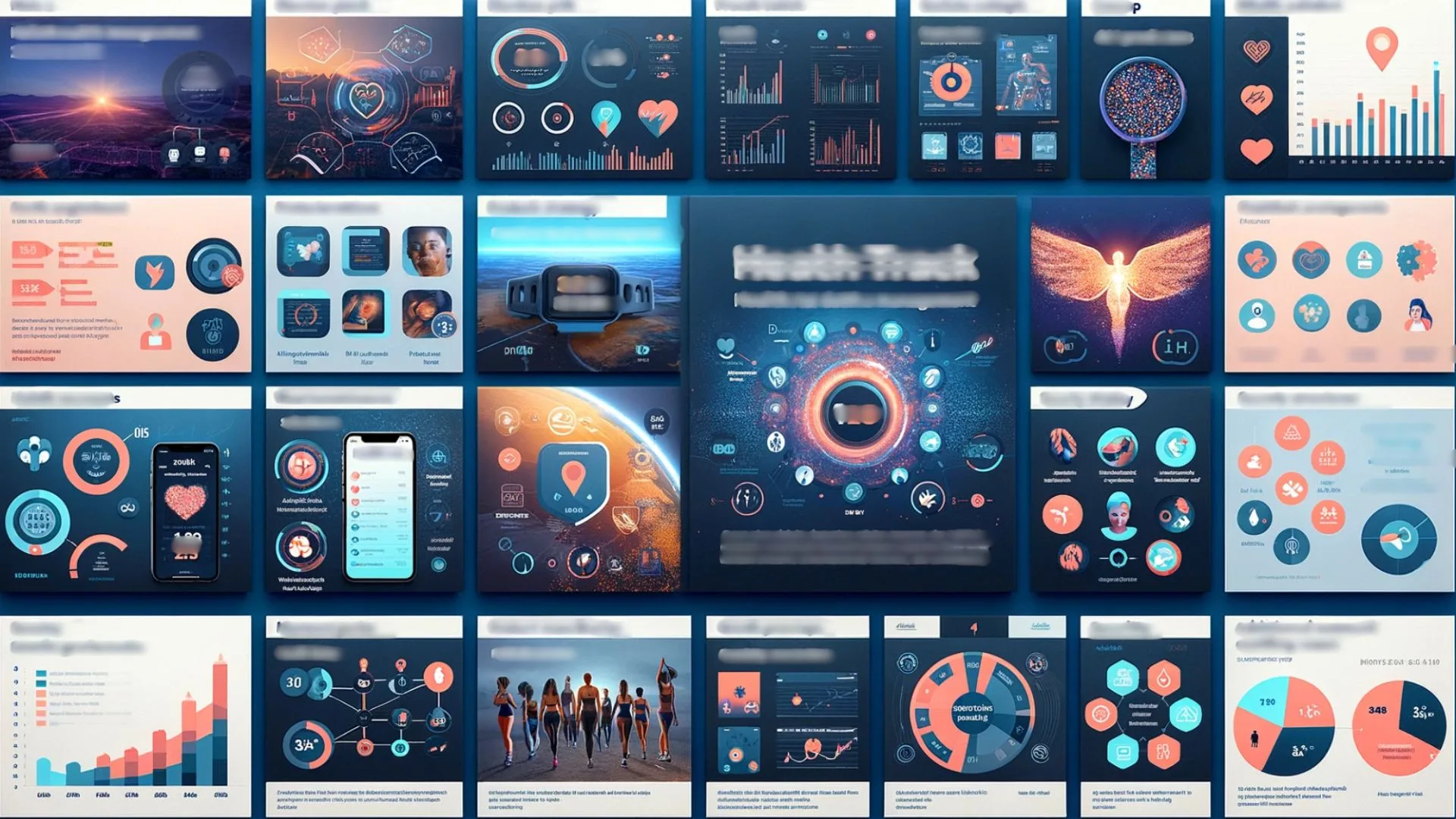
Slide 1: Elevator Pitch
- Product Name: “HealthTrack”
- Subtitle: “Empowering Your Wellness Journey”
Slide 2: SaaS Concept
- Problem: Difficulty in managing health data, lack of personalized health insights.
- Solution: “HealthTrack” consolidates health data from various sources to provide actionable insights and personalized health plans.
- Key Features: Integration with wearables, custom health dashboards, AI-driven health predictions.
Slide 3: Target Audience
- Demographics: Health-conscious individuals, fitness enthusiasts, people with chronic conditions.
- Potential Reach: Projected user base growth driven by increasing health awareness and wearable technology adoption.
Slide 4: Unique Selling Proposition (USP)
- USP: Comprehensive health tracking with predictive analytics to prevent health issues.
- Competitive Advantage: Real-time health monitoring and tailored wellness programs.
Slide 5: Monetization Strategy
- Subscription Model: Monthly and annual subscriptions with different tiers based on feature access.
- Health Coach Services: Personal consultations and ongoing coaching for a premium fee.
Slide 6: Growth Strategy
- User Acquisition: Partnerships with gyms, health clinics, and corporate wellness programs.
- User Retention: Continuous feature updates, community challenges, and rewards for health goals.
Slide 7: Market Potential and Competition
- Market Size: Analysis of the growing digital health market and wearable tech industry.
- Competitive Landscape: Comparison with existing health management platforms.
Slide 8: Product Demo and User Interface
- Visuals of the app interface, dashboard, and typical user interactions.
Slide 9: Security and Data Protection
- Overview of data encryption, compliance with health data regulations, and user privacy protection measures.
Slide 10: Next Steps
- Call to Action: Invitation for health tech investors and partners to join in scaling the solution.
2. EduSuite: An Interactive Learning Management System (LMS)
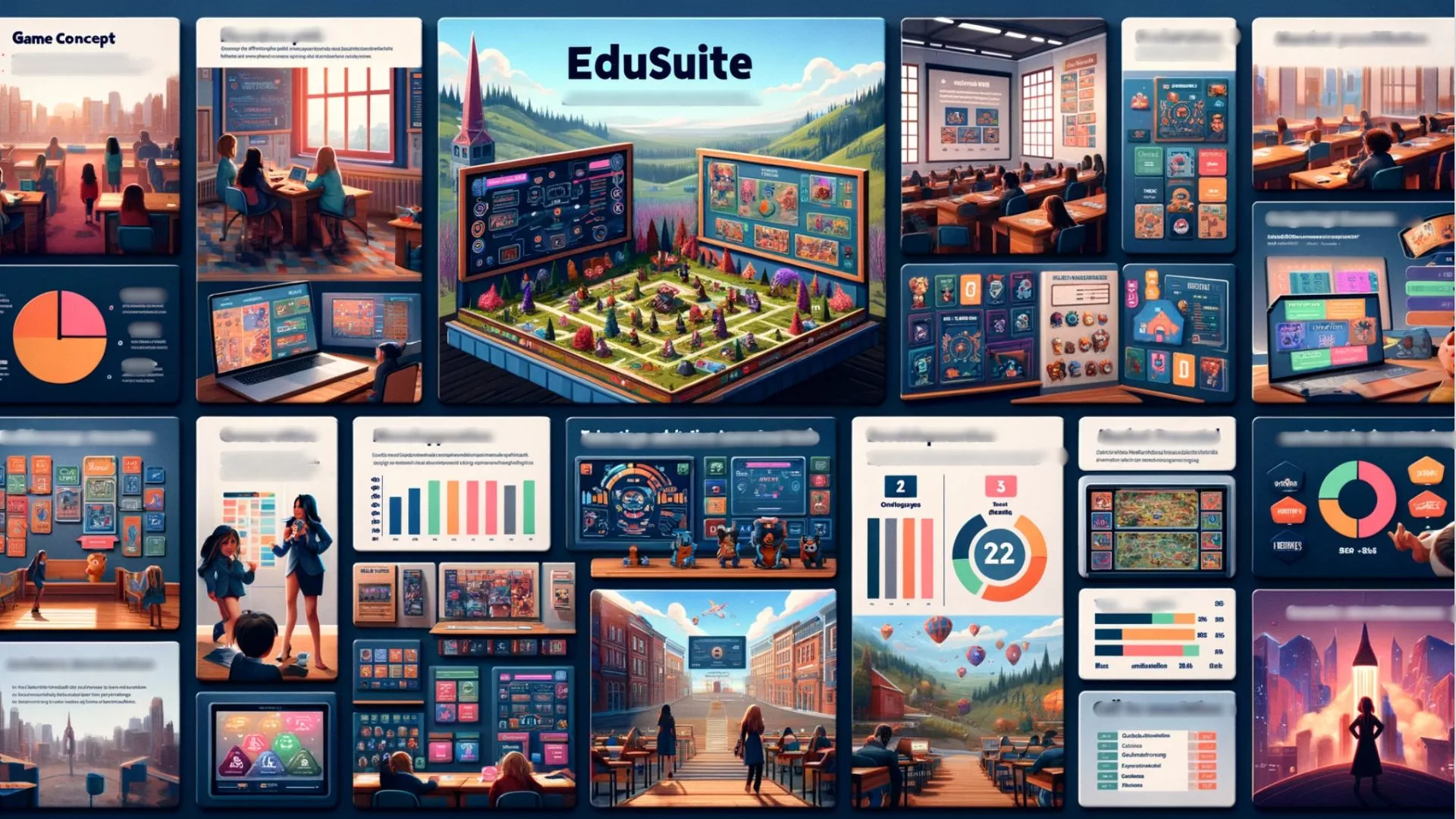
Slide 1: Elevator Pitch
- Product Name: “EduSuite”
- Subtitle: “Revolutionizing Learning Through Innovation”
Slide 2: SaaS Concept
- Problem: Traditional learning management systems are not engaging or flexible enough to cater to diverse learning needs.
- Solution: “EduSuite” offers a dynamic, customizable LMS that supports interactive content and adaptive learning pathways.
- Key Features: Interactive modules, AI-based course recommendations, gamification elements.
Slide 3: Target Audience
- Demographics: Educational institutions, corporate training departments, online educators.
- Potential Reach: Emphasis on the expanding e-learning market and corporate training needs.
Slide 4: Unique Selling Proposition (USP)
- USP: Highly interactive and adaptive learning environment that increases student engagement and completion rates.
- Competitive Advantage: Customizable learning experiences and integration capabilities with various educational tools.
Slide 5: Monetization Strategy
- Subscription Model: Tiered pricing for educational institutions based on student numbers and feature access.
- Corporate Partnerships: Special packages for businesses with training modules and analytics.
Slide 6: Growth Strategy
- User Acquisition: Targeted campaigns to schools and businesses, showcasing the benefits of interactive learning.
- User Retention: Regular feature updates, new learning modules, and responsive customer support.
Slide 7: Market Potential and Competition
- Market Size: Analysis of the e-learning industry’s rapid growth and digital transformation in education.
- Competitive Landscape: Identifying key players and EduSuite’s differentiation in engagement and adaptability.
Slide 8: Product Demo and User Interface
- Display of EduSuite’s user interface, course creation tools, and student engagement metrics.
Slide 9: Security and Data Protection
- Details on compliance with educational data standards, secure cloud hosting, and user data privacy.
Slide 10: Next Steps
- Call to Action: Seeking partnerships with educational content creators and technology providers to enhance offerings.
Related SaaS Pitch Deck Templates
Check out our massive directory of pitch deck templates, or the following related templates:
10 Slide Global Employment Solutions Pitch Deck Template | Google Slides
You’re all set to build a dream team across borders—ready to hire the next superstar…
11 Slide Data and Risk Intelligence Pitch Deck Template: Turning Complex Metrics into Investor Magic | Google Slides
So, here’s the deal: you’ve got a killer concept for a data and risk intelligence…
11 Slide Data Observability Pitch Deck Template | Google Slides
You’ve got the next big thing in data—seriously, your insights could save companies millions, maybe…
Turn ‘Wait, What’s Your Product Again?’ into ‘Take My Money!’ with This B2B Data Solutions Pitch Deck Template | Google Slides
Alright, let’s cut to the chase. You’ve got reams of data, endless spreadsheets, and enough…
Nail Your 15 Slide EdTech Pitch with a Template So Good, It Deserves a Gold Star from Investors | Google Slides
So, you’ve built an app that’s going to change education forever, right? But here’s the…
Data Doesn’t Lie, and Neither Does This Pitch Deck: Get Funded with A 13 Slide Open-Source Bi-Solutions Template | Google Slides
You’re probably here because you’ve got an idea that could change the game – maybe…
Data Overload? Meet the 11 Slide Enterprise Data Solutions Pitch Deck Template That Turns Bytes into Bucks | Google Slides
Alright, here’s the scenario: Your company has loads of data, but instead of running like…
Background Checks on Investors? No, Just the 10 Slide Pitch Deck Template that Wins Them Over | Google Slides
Alright, so you’ve got a rock-solid idea for a game-changing employee background verification service. Maybe…
Bring Investors to the Table (Virtually) with the 11 Slide Digital Collaboration Platform Pitch Deck Template | Google Slides
Alright, so here’s the situation: your team has an incredible vision for a digital collaboration…
Dial Up the Performance: 12 Slide GPU-as-a-Service Pitch Deck Template that Gives Investors a Reason to Press Play | Google Slides
So, here’s the thing: powerful computing doesn’t have to be locked up behind server doors….
Turn Your Workflow Automation Idea into Investor Gold— Starting with this 11 Slide Right Pitch Deck Template | Google Slides
Alright, so you’re swamped with routine tasks, chasing down approvals, and getting bogged down in…
Tired Parents, Meet Tired Investors: How This 10 Slide AI-Powered Parenting Pitch Deck Wins Both | Google Slides
Parenting is already a rollercoaster of emotions, sleepless nights, and constant wondering if you’re doing…
Legal Headaches? Not Here. This 14 Slide AI Contract Software Pitch Deck Template Helps You Get Funded, Fast | Google Slides
Contracts are boring, right? Not for us. We’re the team that saw the endless pain…
13 Slide Solar Energy SaaS Pitch Deck Template: The Only Thing Faster Than Light? Securing Your Funding | Google Slides
So, you’ve built a slick solar energy software, but instead of skyrocketing growth, you’re stuck…
Parenting Gets an Upgrade: A Bold, No-Nonsense 10 Slide Pitch Deck for AI Assistants | Google Slides
Parenting in 2024 feels like trying to solve a Rubik’s cube while riding a rollercoaster,…
From Chaos to Capital: The 11 Slide Incident Management Platform Pitch Deck That Turns Disasters into Dollars | Google Slides
So, your systems crash and burn at the worst possible time, and now everyone’s scrambling…
Pitching Without This 12 Slide React Authentication Pitch Deck Template Is Like Shipping Code Without Testing—Risky and Unfunded | Google Slides
You’re building something cool with React—maybe the next big thing in the app world—but here’s…
11 Slide Collaborative Data Workspace Pitch Deck Template | Google Slides
You’ve got data pouring in from all corners of your business, but it’s a mess,…
9 Slide Open-source Firebase Alternative Pitch Deck Template for Dev-savvy Startups | Google Slides
So, you’re building the next great app, but every time you try to pitch it,…
Personal Wellness App Pitch Deck Case Study
The wellness and health technology industry is booming, with global market size expected to reach…
Remember, these examples are purely hypothetical, and you can adapt them to fit your unique SaaS business idea. The key is to clearly communicate your SaaS concept, identify your target audience, showcase your unique selling proposition, and outline your monetization and growth strategies.
What nobody will tell you: Crucial considerations to keep in mind when developing your SAAS pitch deck and business
10 insights. These are things no advisor, startup event organizer or coach will tell you for free. We’ve done the research and combined it with our experience to give you these insights with no strings attached.
Market Size and Growth Potential in SaaS Pitch Decks
Importance in Pitch Decks: Understanding and presenting the market size and growth potential is crucial in a SaaS pitch deck for several reasons:
- Investor Confidence: Demonstrating a large and growing market assures investors that there’s a substantial opportunity for return on their investment.
- Feasibility and Scalability: It shows the feasibility of your business model and the scalability of your SaaS product in the current and future market landscape.
- Strategic Planning: Reflects your understanding of the market dynamics, helping investors gauge your strategic planning and foresight.
Research Insights:
- According to a report by Gartner, the global SaaS market is expected to grow exponentially, reaching new heights in the next few years. This indicates a thriving and expanding market.
- MarketsandMarkets research highlights that specific sectors within SaaS, like AI, CRM, and ERP, are witnessing higher growth rates, suggesting niche opportunities.
Actionable Steps:
- Conduct Thorough Market Research:
- Utilize resources like Gartner, Forrester, and MarketsandMarkets for the latest market reports.
- Identify growth trends in sub-sectors of SaaS relevant to your product.
- Define Your Target Market:
- Narrow down your target market within the broader SaaS industry.
- Use data to support the size and growth potential of this specific segment.
- Analyze Market Trends:
- Look into emerging trends in the SaaS industry, like the rise of AI integration or the shift towards vertical SaaS.
- Relate these trends to how your product fits into the future of the market.
- Competitor Benchmarking:
- Identify key players in your niche and analyze their market share and growth.
- Use this data to position your product and highlight untapped opportunities.
- Quantify the Opportunity:
- Present statistics and forecasts that quantify the market size and growth potential.
- Use graphs and charts for a clear visual representation of this data in your pitch deck.
- Articulate Market Needs and Your Solution:
- Clearly articulate the specific market needs and how your SaaS product addresses them.
- Link market growth potential to the unique benefits and features of your product.
- Future Outlook:
- Provide a future outlook of the market based on current trends and forecasts.
- Show how your SaaS business is positioned to evolve and grow with the market.
By focusing on these aspects, your pitch deck will not only demonstrate a solid understanding of the market size and growth potential but also showcase how your SaaS product is uniquely positioned to capitalize on these opportunities. This approach will help in building a compelling case for potential investors, highlighting both the current value and future potential of your SaaS business.
Unique Value Proposition (UVP) and Differentiation in SaaS Pitch Decks
Importance in Pitch Decks: Articulating a clear and compelling Unique Value Proposition (UVP) is pivotal in a SaaS pitch deck for several key reasons:
- Standing Out in a Crowded Market: The SaaS industry is highly competitive. A well-defined UVP helps differentiate your product from numerous similar offerings.
- Investor Attraction: Investors are inundated with pitches. A strong UVP can capture their interest by clearly stating what sets your SaaS product apart.
- Customer-Centric Focus: It demonstrates an understanding of your target customers’ needs and how your product uniquely meets those needs.
Research Insights:
- A study by Bain & Company highlights that companies with a clearly defined UVP tend to retain and attract more customers and enjoy higher customer loyalty.
- According to Harvard Business Review, businesses that successfully differentiate based on unique features or services can command a price premium.
Actionable Steps:
- Identify Key Differentiators:
- Analyze your product features, benefits, and services that are not offered by competitors.
- Focus on aspects like superior technology, unique pricing models, customer service excellence, or innovative features.
- Understand Customer Pain Points:
- Conduct market research to understand the challenges and needs of your target audience.
- Tailor your UVP to address these specific pain points.
- Benchmark Against Competitors:
- Perform a competitive analysis to understand how competitors position themselves.
- Highlight what you do better or differently in your pitch deck.
- Craft a Concise UVP Statement:
- Develop a clear, concise statement that encapsulates the essence of your product’s unique value.
- Ensure it is easily understandable and resonates with both investors and potential customers.
- Integrate UVP into Your Storytelling:
- Weave your UVP into the narrative of your pitch deck, making it a central theme of your presentation.
- Use storytelling to illustrate how your product uniquely solves problems or adds value.
- Validate with Testimonials or Case Studies:
- Include customer testimonials or case studies that reinforce your UVP.
- Real-world examples can powerfully demonstrate the effectiveness of your solution.
- Highlight Future Potential:
- Discuss how your UVP will continue to set you apart as the market evolves.
- Show how your product is scalable and adaptable to future market changes.
By focusing on these steps, your SaaS pitch deck will effectively communicate a strong Unique Value Proposition, setting the stage for a compelling argument to investors. It’s not just about being different; it’s about being strategically different in ways that matter to your target market and resonate with investors. This approach will help in establishing a clear market position and showcasing the unique value your SaaS product brings to the table.
Revenue Model and Monetization Strategy in SaaS Pitch Decks
Importance in Pitch Decks: A well-defined revenue model and monetization strategy are crucial in a SaaS pitch deck for several reasons:
- Demonstrating Financial Viability: Investors need to understand how your SaaS business will generate revenue and become profitable.
- Aligning with Market Expectations: Different SaaS segments have varying monetization norms. Your strategy should align with these to be credible.
- Long-term Sustainability: Showcasing a robust monetization strategy indicates the long-term sustainability and growth potential of your SaaS business.
Research Insights:
- According to a report by Forrester, subscription-based models are predominant in SaaS, but usage-based pricing is gaining traction due to its alignment with customer value perception.
- McKinsey & Company’s research suggests that SaaS companies with flexible monetization models can adapt better to market changes and customer needs.
Actionable Steps:
- Choose the Right Pricing Model:
- Evaluate different models like subscription-based, freemium, or usage-based pricing.
- Consider your target market, product type, and competitive landscape in choosing the most suitable model.
- Define Pricing Tiers and Structures:
- Develop tiered pricing structures that cater to different segments of your market.
- Ensure clarity in what each tier offers and its value proposition.
- Analyze Cost and Value Drivers:
- Understand the cost of delivering your service and the value it provides to customers.
- Price your product in a way that reflects this value while ensuring profitability.
- Incorporate Market Research:
- Use market research to validate your pricing strategy.
- Compare with competitors to ensure your pricing is competitive yet profitable.
- Plan for Scalability:
- Design your monetization strategy to be scalable as your customer base grows.
- Consider how pricing can evolve with product development and market expansion.
- Highlight Revenue Projections:
- Include detailed revenue projections in your pitch deck.
- Use data to back up these projections, showing realistic and attainable goals.
- Showcase Customer Acquisition and Retention Strategies:
- Explain how your monetization strategy ties into customer acquisition and retention.
- Highlight any unique approaches that enhance customer lifetime value.
- Discuss Adaptability:
- Address how your revenue model can adapt to changes in the market or customer needs.
- Show foresight in planning for potential market shifts.
By focusing on these steps, your SaaS pitch deck will effectively communicate a well-thought-out revenue model and monetization strategy. This approach not only assures investors of your business’s financial viability but also demonstrates a deep understanding of the market and customer needs. It’s crucial to convey that your monetization strategy is not just about making money, but about creating value for customers in a way that drives sustainable, long-term growth for your SaaS business.
Customer Acquisition and Retention Strategies in SaaS Pitch Decks
Importance in Pitch Decks: In a SaaS pitch deck, outlining effective customer acquisition and retention strategies is vital for several reasons:
- Demonstrating Market Penetration Capability: Investors need to see a clear plan for how you’ll attract and retain customers in a competitive SaaS market.
- Reflecting on Customer Lifecycle Value: It’s crucial to show an understanding of the customer lifecycle and how you’ll maximize lifetime value (LTV).
- Indicating Sustainable Growth: Effective acquisition and retention strategies are key indicators of your business’s potential for sustainable growth.
Research Insights:
- Research by Bain & Company indicates that a 5% increase in customer retention can increase company revenue by 25% to 95%.
- According to Harvard Business Review, the cost of acquiring a new customer can be anywhere from 5 to 25 times more expensive than retaining an existing one.
Actionable Steps:
- Identify Target Customer Segments:
- Clearly define your target customer segments based on market research.
- Tailor your acquisition strategies to these specific segments.
- Develop a Multi-Channel Acquisition Plan:
- Utilize a mix of channels like content marketing, SEO, PPC, and social media.
- Align these channels with where your target customers are most active.
- Leverage Inbound Marketing:
- Focus on inbound marketing strategies to draw customers with valuable content, tools, and resources.
- Use lead magnets and content marketing to attract potential customers.
- Implement Effective Onboarding Processes:
- Develop an onboarding process that educates new users and demonstrates immediate value.
- Use automated workflows and personalized guidance to enhance user experience.
- Focus on Customer Success and Support:
- Invest in a robust customer support system to resolve issues promptly.
- Implement customer success programs to ensure users achieve their desired outcomes.
- Utilize Data-Driven Insights:
- Analyze customer data to understand behavior patterns and preferences.
- Use these insights to refine your acquisition and retention strategies.
- Engage in Continuous Feedback Loops:
- Regularly collect and act on customer feedback to improve your product and services.
- Use surveys, user testing, and feedback tools to gather insights.
- Showcase Retention Metrics in Your Pitch:
- Include key metrics like churn rate, customer lifetime value, and repeat purchase rate in your pitch deck.
- Use these metrics to demonstrate the effectiveness of your retention strategies.
- Highlight Case Studies or Testimonials:
- Share success stories or case studies that show how you’ve successfully acquired and retained customers.
- Testimonials can add a layer of credibility and real-world proof.
By focusing on these steps, your SaaS pitch deck will effectively communicate a comprehensive strategy for acquiring and retaining customers. This approach not only assures investors of your ability to grow and maintain a customer base but also demonstrates a deep understanding of the importance of customer lifecycle management in the SaaS industry. It’s essential to convey that your strategies are designed to create a sustainable growth trajectory by maximizing customer value and minimizing churn.
Technology and Product Innovation in SaaS Pitch Decks
Importance in Pitch Decks: In a SaaS pitch deck, emphasizing technology and product innovation is crucial for several reasons:
- Showcasing Competitive Edge: In the rapidly evolving SaaS market, showcasing cutting-edge technology or innovative features can set your product apart from competitors.
- Building Investor Confidence: Investors are often attracted to SaaS companies that demonstrate a commitment to innovation, as it suggests long-term growth and adaptability.
- Reflecting Market Responsiveness: Highlighting ongoing innovation indicates your company’s ability to respond to changing market demands and customer needs.
Research Insights:
- A study by Deloitte reveals that companies prioritizing innovation tend to have higher growth rates and are more likely to lead in their respective markets.
- According to PwC’s Innovation Benchmark Report, 55% of companies investing in innovation are more successful in achieving rapid growth.
Actionable Steps:
- Detail Your Core Technology:
- Clearly explain the technology behind your SaaS product, focusing on unique or proprietary aspects.
- Highlight how your technology is advanced compared to existing solutions.
- Emphasize Unique Features and Capabilities:
- Identify and present the innovative features of your product that solve problems in ways competitors do not.
- Use case scenarios or user stories to illustrate these features in action.
- Discuss Ongoing R&D Efforts:
- Share insights into your research and development efforts, showing commitment to continuous improvement and innovation.
- Mention any patents, if applicable, to underscore the uniqueness of your technology.
- Highlight Scalability and Flexibility:
- Demonstrate how your technology is scalable and can adapt to growing customer needs and market changes.
- Discuss the flexibility of your product in integrating with other systems or platforms.
- Showcase User-Centric Design and Experience:
- Focus on how your product design and user experience are tailored to meet user needs innovatively.
- Include user feedback or testimonials to validate your claims.
- Present a Roadmap for Future Development:
- Provide a clear roadmap of future product enhancements and innovations.
- Show how these developments will continue to keep your product at the forefront of the market.
- Use Data and Metrics to Support Claims:
- Include relevant metrics or data that demonstrate the effectiveness and efficiency of your technology.
- Metrics could include performance improvements, user engagement rates, or reduction in operational costs.
- Leverage Visuals for Complex Concepts:
- Use diagrams, flowcharts, or videos to explain complex technological concepts in an easily digestible format.
- Visual aids can help convey your message more effectively than text-heavy slides.
By focusing on these steps, your SaaS pitch deck will effectively communicate the strength and uniqueness of your technology and product innovation. This approach not only showcases your product’s current capabilities but also assures investors of its potential to stay relevant and competitive in the future. It’s crucial to convey that your technology is not just advanced but also strategically aligned with market needs and customer expectations, driving both current success and future growth.
Competitive Analysis in SaaS Pitch Decks
Importance in Pitch Decks: Incorporating a thorough competitive analysis in a SaaS pitch deck is essential for several key reasons:
- Demonstrating Market Awareness: Shows investors that you have a deep understanding of the market landscape and where your product fits within it.
- Highlighting Competitive Edge: Clearly articulates how your SaaS solution is different and potentially superior to existing alternatives.
- Strategic Positioning: Helps in strategically positioning your product in the market, showcasing how it addresses gaps left by competitors.
Research Insights:
- A report by CB Insights states that “lack of market need” is a top reason for startup failure, underscoring the importance of understanding the competitive landscape.
- According to Harvard Business School, businesses that conduct regular competitive analysis are better positioned to adapt to market changes and innovate effectively.
Actionable Steps:
- Identify Key Competitors:
- Compile a list of direct and indirect competitors in your SaaS niche.
- Include both established players and emerging startups.
- Analyze Competitor Offerings:
- Conduct a detailed analysis of competitors’ products, focusing on features, pricing, customer base, and market positioning.
- Identify any gaps or weaknesses in their offerings.
- Evaluate Their Market Strategy:
- Look into competitors’ marketing strategies, sales approaches, and customer engagement tactics.
- Assess their strengths and weaknesses in these areas.
- Gather Customer Feedback on Competitors:
- Collect feedback from users of competitor products to understand their satisfaction levels and pain points.
- Use this information to refine your value proposition.
- Benchmark Against Industry Standards:
- Compare your product against industry benchmarks and best practices.
- Highlight areas where your product excels or offers something unique.
- Present a SWOT Analysis:
- Conduct a SWOT analysis (Strengths, Weaknesses, Opportunities, Threats) for your product in relation to competitors.
- Present this analysis in your pitch deck to demonstrate strategic awareness.
- Showcase Your Unique Selling Points (USPs):
- Clearly articulate your USPs that set you apart from competitors.
- Focus on how these USPs translate into real benefits for users.
- Discuss Future Strategies to Stay Ahead:
- Outline your strategies for maintaining a competitive edge in the evolving market.
- Include plans for innovation, market expansion, or customer engagement.
- Use Visuals for Comparative Analysis:
- Employ charts, graphs, or matrices to visually compare your product with competitors.
- Visual comparisons can be more impactful and easier to grasp.
By focusing on these steps, your SaaS pitch deck will effectively communicate a comprehensive understanding of the competitive landscape. This approach not only demonstrates your product’s strengths and market fit but also reassures investors of your strategic foresight and ability to navigate and excel in a competitive environment. It’s crucial to convey that your competitive analysis is not just a snapshot of the current market but a tool for ongoing strategic planning and innovation.
Financial Projections and Key Metrics in SaaS Pitch Decks
Importance in Pitch Decks: In a SaaS pitch deck, presenting well-structured financial projections and key metrics is crucial for several reasons:
- Demonstrating Financial Health and Potential: Investors need to understand the current financial status and future potential of your SaaS business.
- Building Credibility: Accurate and realistic financial projections show that you have a solid grasp of your business model and market dynamics.
- Assessing Risk and Return: Investors use these projections and metrics to assess the risk and potential return on their investment.
Research Insights:
- According to a study by McKinsey, startups with clear financial projections are more likely to secure funding, as they demonstrate a thorough understanding of their business model.
- A report by Forbes suggests that SaaS companies with strong metrics in customer acquisition costs (CAC), lifetime value (LTV), and churn rates are more attractive to investors.
Actionable Steps:
- Develop Realistic Revenue Projections:
- Create revenue projections for the next 3-5 years, based on your current growth rate, market size, and sales pipeline.
- Factor in realistic assumptions about market penetration and customer acquisition.
- Outline Cost Structures:
- Detail your cost structure, including fixed and variable costs.
- Highlight how economies of scale might reduce costs over time.
- Focus on SaaS-Specific Metrics:
- Emphasize key SaaS metrics such as Monthly Recurring Revenue (MRR), Annual Recurring Revenue (ARR), Lifetime Value (LTV), Customer Acquisition Cost (CAC), and Churn Rate.
- Explain how these metrics are critical for evaluating the health and scalability of your SaaS business.
- Break-Even Analysis:
- Include a break-even analysis to show when your company expects to become profitable.
- This helps investors understand the timeline for return on investment.
- Cash Flow Projections:
- Present a cash flow forecast, highlighting how and when cash is expected to flow in and out of your business.
- This is crucial for understanding the working capital needs of your business.
- Scenario Analysis:
- Provide best-case, worst-case, and most likely financial scenarios.
- This demonstrates preparedness for different market conditions.
- Use of Funds:
- Clearly articulate how any investment will be used and its impact on growth and financial projections.
- This shows investors the strategic thinking behind fund allocation.
- Graphical Representations:
- Use graphs and charts to make financial data more accessible and understandable.
- Visuals can help convey complex financial information more effectively.
- Historical Performance (if applicable):
- If your company has been operating for a while, include historical financial performance.
- This provides a baseline for your projections and can build credibility.
By focusing on these steps, your SaaS pitch deck will effectively communicate the financial viability and growth potential of your business. This approach not only assures investors of the soundness of your financial planning but also demonstrates a deep understanding of the key metrics that drive success in the SaaS industry. It’s crucial to convey that your financial projections are not just optimistic estimates but are grounded in market realities and strategic planning.
Case Studies or Success Stories in SaaS Pitch Decks
Importance in Pitch Decks: Incorporating case studies or success stories in a SaaS pitch deck is vital for several reasons:
- Building Credibility and Trust: Real-world examples of your product’s success can significantly boost credibility with potential investors.
- Demonstrating Product Efficacy: Success stories provide tangible evidence of your product’s value and effectiveness in solving real-world problems.
- Illustrating Market Adoption: They showcase customer satisfaction and market adoption, which are key indicators of potential for future success.
Research Insights:
- A survey by B2B Marketing Zone found that case studies are among the top three most influential types of content for B2B buyers.
- According to the Content Marketing Institute, 73% of B2B marketers say that case studies are the best way to generate leads.
Actionable Steps:
- Select Relevant Success Stories:
- Choose case studies that are most relevant to your target investors and highlight different aspects of your product.
- Ensure these stories resonate with the challenges and needs of your potential customers.
- Detail the Problem and Solution:
- Clearly articulate the specific problem your customer faced and how your SaaS solution provided a resolution.
- This helps in painting a picture of your product’s utility in real-world scenarios.
- Quantify the Impact:
- Include quantifiable results such as increased revenue, cost savings, improved efficiency, or enhanced customer satisfaction.
- Metrics and numbers add weight to your claims.
- Incorporate Customer Testimonials:
- Use direct quotes from customers to add authenticity and a personal touch to the case studies.
- Testimonials can be powerful in conveying customer satisfaction and product value.
- Visualize Success Stories:
- Use visuals like graphs, charts, or before-and-after scenarios to illustrate the impact of your solution.
- Visual aids can make the success stories more engaging and easier to understand.
- Discuss the Broader Implications:
- Highlight how these success stories are indicative of broader market trends or opportunities.
- Show how your solution can be scaled or adapted to similar problems or industries.
- Include a Variety of Cases:
- Present a range of case studies that cover different industries, company sizes, or use cases.
- This demonstrates the versatility and broad appeal of your product.
- Link to Long-Term Vision:
- Connect the success stories to your long-term vision and strategy for the company.
- Show how these early successes are stepping stones towards larger goals.
- Update with Ongoing Successes:
- Keep your pitch deck updated with new and relevant success stories.
- This shows continuous growth and market traction.
By focusing on these steps, your SaaS pitch deck will effectively leverage case studies and success stories to build trust and demonstrate the real-world value of your product. This approach not only validates your product’s market fit but also showcases its proven track record, making a compelling case for potential investment. It’s crucial to convey that these success stories are not just isolated incidents but are reflective of the consistent and scalable impact your SaaS solution can deliver.
Team and Leadership in SaaS Pitch Decks
Importance in Pitch Decks: The team and leadership section is a cornerstone of a SaaS pitch deck for several critical reasons:
- Investor Confidence: Investors often bet on the team as much as the idea. A strong team indicates the capability to execute the business plan and adapt to challenges.
- Expertise and Experience: Demonstrating the team’s expertise and experience in SaaS or related fields can significantly boost credibility.
- Leadership and Vision: Showcasing the leadership’s vision and commitment can be a decisive factor in securing investment.
Research Insights:
- Harvard Business Review reports that startups with a balanced and experienced management team have a significantly higher chance of success.
- According to Forbes, many venture capitalists consider the team as the most important factor when deciding to invest.
Actionable Steps:
- Highlight Key Team Members:
- Focus on the founders and key team members, outlining their roles and relevance to the business.
- Include brief bios that highlight their expertise, experience, and past successes, especially in the SaaS industry or in roles critical to company growth.
- Showcase Relevant Experience:
- Emphasize any previous entrepreneurial successes, industry experience, or technical expertise.
- Highlight experiences that directly relate to the challenges and needs of running a SaaS business.
- Illustrate the Team’s Cohesion and Commitment:
- Provide examples or stories that demonstrate the team’s ability to work cohesively, especially in challenging situations.
- Mention any long-term commitments or sacrifices made by team members, indicating their dedication to the company’s success.
- Include Advisors and Mentors:
- If you have industry advisors or mentors, mention them and their credentials.
- This can add an extra layer of credibility and support to your team’s profile.
- Demonstrate Diversity of Skills:
- Show how your team’s diverse skill set complements each other, covering all critical areas of the business (e.g., technical, marketing, sales, financial).
- This diversity indicates a well-rounded and capable team.
- Link Team Strengths to Business Goals:
- Connect the team’s skills and experiences directly to your business goals and strategies.
- Explain how the team’s composition is strategically aligned with the company’s roadmap.
- Use Professional Photos and Consistent Formatting:
- Include professional photos of team members to add a personal touch.
- Use consistent formatting for each member’s profile to maintain a professional look.
- Share Team Achievements and Milestones:
- Mention any significant milestones or achievements the team has accomplished, especially those relevant to building or growing a SaaS business.
- This can include successful product launches, key partnerships, or notable growth metrics.
- Highlight Ongoing Development:
- Indicate any ongoing training or development initiatives the team is undertaking to stay ahead in the industry.
- This shows a commitment to continuous improvement and adaptation.
By focusing on these steps, your SaaS pitch deck will effectively communicate the strength and capability of your team and leadership. This approach not only builds investor confidence in your team’s ability to execute the business plan but also highlights the strategic alignment of their skills with the company’s long-term vision. It’s crucial to convey that your team is not just skilled but also passionately committed to the success of the SaaS venture.
Exit Strategy or Future Vision in SaaS Pitch Decks
Importance in Pitch Decks: Articulating a clear exit strategy or future vision in a SaaS pitch deck is crucial for several reasons:
- Investor Perspective: Investors are interested in understanding the potential return on their investment, and an exit strategy provides a roadmap for this.
- Long-term Planning: It demonstrates strategic foresight and the ability to think long-term, which is crucial for sustainable business growth.
- Alignment of Goals: A well-defined future vision or exit strategy ensures that the company’s goals are aligned with those of its investors.
Research Insights:
- A study by Harvard Business School indicates that startups with a clear long-term vision and exit strategy tend to attract more seasoned investors.
- According to Forbes, companies with a well-defined exit strategy are often more disciplined and focused, leading to better performance.
Actionable Steps:
- Define Your Long-Term Vision:
- Clearly articulate where you see your SaaS company in the next 5-10 years.
- This vision should include market positioning, potential growth areas, and how you plan to evolve with industry trends.
- Outline Potential Exit Scenarios:
- Present potential exit strategies such as acquisition, merger, IPO, or passing the business to a successor.
- Tailor these scenarios to what is realistic and attractive in the SaaS industry.
- Discuss Investor ROI:
- Explain how each exit scenario could potentially provide a return on investment for your investors.
- Include estimated timelines and potential valuation at exit.
- Highlight Industry Trends and Benchmarks:
- Use industry benchmarks and trends to support your proposed exit strategy.
- This might include citing examples of recent acquisitions or IPOs in the SaaS sector.
- Showcase Scalability and Market Potential:
- Demonstrate how your business model and technology are scalable and can capture a significant market share, making it an attractive target for exit scenarios.
- Investors are keen on backing businesses with high scalability potential.
- Align Exit Strategy with Business Goals:
- Ensure that your exit strategy aligns with your overall business goals and growth strategies.
- This alignment shows coherence and strategic planning in your business approach.
- Prepare for Different Outcomes:
- Be prepared to discuss different exit outcomes and how you plan to navigate each scenario.
- This preparation indicates flexibility and adaptability, which are key in the dynamic SaaS industry.
- Communicate the Impact on Stakeholders:
- Discuss how your exit strategy will impact various stakeholders, including employees, customers, and investors.
- This shows a comprehensive understanding of the business ecosystem.
- Update as the Business Evolves:
- Keep your exit strategy and future vision updated as your business grows and the market evolves.
- An evolving strategy indicates responsiveness to market changes and business growth.
By focusing on these steps, your SaaS pitch deck will effectively communicate a well-thought-out exit strategy or future vision. This approach not only aligns with investor interests but also demonstrates your commitment to the long-term success and sustainability of your business. It’s crucial to convey that your exit strategy or future vision is not just a formal requirement but a strategic component of your business planning.
Use these insights and make a winning pitch. If you want to talk about them, reach out to me and book a call.
How to creatively pitch your SaaS Startup?
Pitching a SaaS startup requires creativity and a memorable approach to stand out. Here are some novel and slightly unconventional ideas that can make a pitch unforgettable:
- Interactive Product Demo:
- Turn your pitch into an interactive experience by integrating a live product demo.
- Engage the audience by letting them interact with your product in real-time through their smartphones or tablets.
- Storytelling with a Twist:
- Craft a narrative around a fictional yet relatable character who faces challenges solved by your product.
- Elevate this by incorporating elements of theater, like costume or props, to bring the story to life.
- Augmented Reality Presentation:
- Use augmented reality (AR) technology to present your product features and market data in a 3D space around you.
- This can be especially impactful in showing complex data or how your product fits into the user’s world.
- Pitch in Reverse:
- Start your pitch by outlining the future vision of your company after achieving success, then work backward to the present, detailing the steps and strategies to get there.
- This reverse storytelling can be a refreshing change from the typical pitch structure.
- Incorporate a Flash Mob:
- Organize a flash mob that suddenly appears during your presentation to perform a short, relevant act or dance.
- This can be a metaphor for your product’s impact or a creative way to demonstrate user engagement.
- Virtual Reality Journey:
- Use VR headsets to take investors on a virtual journey through a day in the life of your user before and after using your product.
- This immersive experience can powerfully convey your product’s value proposition.
- Gamify Your Pitch:
- Turn your pitch into a short, interactive game where the audience makes decisions based on scenarios where your product could be used.
- This interactive approach can make your pitch more engaging and memorable.
- Use a Mini-Series Approach:
- Break your pitch into “episodes”, each focusing on a different aspect of your business (market, product, financials, etc.).
- This can keep the audience intrigued and waiting for what’s next, like a TV series.
- Live Customer Testimonials:
- If feasible, bring in a real customer to share their experience and the impact your product has had on their life or business.
- Authentic testimonials can be very persuasive.
- Pitch with a Social Experiment:
- Conduct a live social experiment with the audience to demonstrate a problem your product solves.
- This can be a powerful visual representation of the need for your solution.
- Time Travel Theme:
- Dress as a time traveler and present your pitch as if you’re from the future, showing how your product has changed the world. Use futuristic props and visuals to enhance the theme.
- Interactive Theater:
- Turn your pitch into a short play, with actors portraying the problem your software solves. This theatrical representation can make the problem and solution more relatable and memorable.
- Musical Pitch:
- Compose a catchy song or jingle about your product and perform it. Music can be a powerful tool to make your message stick in the audience’s mind.
- Escape Room Challenge:
- Create an escape room-style challenge that the audience can participate in, which metaphorically represents the problem your SaaS solves. It’s engaging and can effectively demonstrate the value of your solution.
- Mock News Report:
- Set up your presentation as a mock news report or documentary, complete with interviews, reports, and breaking news segments about your product and its impact on the industry.
- Product as a Superhero:
- Create a superhero character that embodies your product. Use a comic strip or animated video to tell the story of how this superhero solves major problems, akin to how your product works.
- Silent Movie Style:
- Present your pitch in the style of a silent movie, using music, exaggerated expressions, and text placards. This can be a unique way to convey your message and stand out.
- Magic Show:
- Incorporate magic tricks or illusions that metaphorically represent your product’s features and benefits. This can add an element of surprise and entertainment to your pitch.
- Science Experiment:
- Conduct a live science experiment on stage that visually demonstrates the problem your product addresses or the effectiveness of your solution.
- Interactive Polls and Quizzes:
- Use live polls or quizzes during your presentation to engage the audience and collect real-time feedback or opinions related to your product or market.
- Virtual Host or AI Assistant:
- Use a virtual AI assistant or hologram to co-present with you, showcasing the technological innovation and futuristic approach of your company.
- Product-Related Fashion Show:
- Host a mini fashion show where each outfit or accessory represents a feature or benefit of your product, combining style with storytelling.
- Cooking Show Format:
- Present your pitch as if you’re hosting a cooking show, where each ingredient represents a component of your product or business model, culminating in the “final dish” which is your complete product.
- Interactive Art Installation:
- Create an art piece or installation that represents your product or the problem it solves. Invite the audience to interact with it before or after your pitch.
- Choose Your Own Adventure:
- Let the audience make choices at key points in your presentation, leading to different outcomes or paths. This can illustrate the flexibility and adaptability of your product.
These ideas are designed to make your pitch not just a presentation, but an experience that captivates and stays with the audience. Remember, the key is to tie these creative elements back to the core message and value of your SaaS product.
10 Tips To Create An Amazing SaaS Pitch Deck
Here are 10 tips to help you create a compelling pitch deck:
- Start with a clear and concise value proposition: Begin your pitch deck with a single sentence or phrase that describes the core value your SaaS product offers. This statement should be easy to understand and communicate the problem your product solves.
- Address the problem: Clearly explain the problem or pain point your target audience faces, and demonstrate your deep understanding of their needs. Use relevant data or anecdotes to emphasize the importance of addressing this problem.
- Present your solution: Describe how your SaaS product solves the problem you’ve identified, and highlight its unique features and benefits. Use visuals, such as screenshots or demo videos, to help your audience understand how your product works.
- Define your target market: Provide a clear and specific description of your target customers, including their demographics, industries, and any other relevant characteristics. Show that you’ve done thorough market research and understand the size and potential of your market.
- Explain your business model: Clearly outline how your SaaS company generates revenue, such as through subscription plans, tiered pricing, or freemium models. Be sure to include details about pricing, customer acquisition, and retention strategies.
- Showcase your competitive advantage: Identify your key competitors and explain how your product stands out. Highlight your unique selling points, such as innovative features, exceptional customer service, or a superior user experience.
- Share your go-to-market strategy: Describe your marketing and sales strategies for acquiring new customers, such as content marketing, social media, paid advertising, or partnerships. Also, discuss your plans for scaling your business and expanding into new markets.
- Provide traction and metrics: Share any key performance indicators (KPIs) or milestones you’ve achieved, such as user growth, revenue, or customer testimonials. These metrics help demonstrate your product’s value and potential to investors.
- Introduce your team: Highlight the experience, skills, and expertise of your founding team and key employees. Show that your team has the necessary background and passion to execute your vision and drive your company’s success.
- Financial projections and ask: Provide a realistic forecast of your company’s financial performance, including projected revenue, expenses, and profit margins. Clearly state the funding amount you’re seeking and how you plan to use the investment to grow your business.
5 Tips To Create A Visually Stunning SaaS Pitch Deck
To create a visually stunning SaaS pitch deck, consider the following design tips:
- Use a consistent color scheme: Choose a color scheme that reflects your brand identity and stick to it throughout the pitch deck. Using consistent colors helps create a cohesive look and feel and makes your presentation appear more professional. Limit your palette to 2-4 main colors and use them strategically to highlight key points or differentiate sections.
- Emphasize simplicity and clarity: Avoid clutter and overcrowding your slides with too much text or visuals. Keep your slides clean and straightforward, focusing on one main idea per slide. Use bullet points or short phrases instead of lengthy paragraphs to convey your message. Choose a clear, easy-to-read font and maintain a consistent font size and style across all slides.
- Use visuals to support your message: Incorporate images, icons, and diagrams that complement your content and help convey your message more effectively. Use high-quality, relevant visuals, such as screenshots of your product, charts showing growth, or simple infographics to illustrate complex ideas. Be mindful of image resolution and avoid stretching or distorting visuals.
- Apply a consistent layout and hierarchy: Create a consistent layout for your slides, using a grid system or templates to ensure elements are aligned and well-organized. Establish a visual hierarchy by using different font sizes, weights, or colors to distinguish between headings, subheadings, and body text. This approach makes your content easier to follow and digest for your audience.
- Utilize white space effectively: Don’t be afraid to leave empty spaces on your slides, as white space helps create balance and prevents your presentation from looking cluttered. White space can guide the viewer’s eye, emphasize important elements, and improve overall readability.
What Investors Would Ask A SaaS Owner
Some of the questions you might encounter when presenting your SaaS, are:
- Are you selling a SaaS solution to B2B customers?
- Do you offer both a desktop and mobile app, or just desktop?
- Do you have angel investors with significant experience who advise you on strategy?
- What is your MRR today?
- What is the story?
- Will you spend the bulk of it on product development to build your MVP?
- Where do you position yourself vs. the competition?
- What about your tech stack? Is it competitive?
SaaS Owners Also Ask
How long should a SaaS pitch deck be?
A SaaS pitch deck should ideally be between 10-20 slides. This length allows you to present your key points effectively while maintaining your audience’s attention.
Is there a difference when creating a SaaS pitch deck for series a, series b, or series c funding round?
Yes, there are differences when creating a SaaS pitch deck for Series A, Series B, or Series C funding rounds. As your company progresses through funding stages, the focus and expectations of investors change. Here’s a brief overview of the differences:
- Series A: In this early-stage round, investors are interested in your product-market fit, the size of your target market, and your business model. Focus on presenting a clear value proposition, demonstrating market potential, and outlining plans for growth and scaling.
- Series B: At this stage, your company has likely shown significant progress and traction. Investors want to see how you’ve utilized previous funding, achieved key milestones, and improved your key performance indicators (KPIs). Emphasize growth strategy, customer acquisition, and plans to expand your team or enter new markets.
- Series C: For this more mature funding stage, investors expect to see a proven track record of success, solid financials, and a clear path to profitability or exit strategy (e.g., IPO, acquisition). Focus on presenting detailed financial projections, showcasing your market dominance, and highlighting any strategic partnerships or acquisitions.
Final Thoughts
There’s my take on creating a pitch deck for a SaaS. There are a-lot of different things to take into account, but if used correctly, you’ll be securing your next round for sure.
For more details about creating and structuring the ideal and effective deck, feel free to check out the main page. I got tips, tricks, mistakes and more for you to use and abuse!
You got this!
But if you don’t got it:
Join hundreds of successful entrepreneurs who’ve transformed their pitch decks with my help.
Let me develop an investor ready deck by using my hands-off approach, which includes: market research, copy, design, financials, narrative and strategy.
One week turnaround time.
The least you will get is 10 actionable tips & strategies to own that next presentation, worth $599, for free.

Or visit my pitch deck service page for more info.
More Resources
Check my cornerstone guide on pitch decks that helped my clients win more than 4,000,000$ in funding:
You’ll learn how to create a pitch deck by following my bulletproof step-by-step guide that helped my clients get $4+mill in funding. It includes:
- How to build the slides (including elevator pitch slide, financials slide, and more)
- Startup pitch deck examples
- What investors need to see
- What a pitch deck needs to be
- What a pitch deck can’t be
- Tips and tricks when creating a pitch presentation
Check out some of the essential 101 guides:
Mastering the Financial Projections Slide: Turning First Impressions into Lasting Opportunities
You’re convinced your startup is the next big thing, but somehow, your pitch keeps landing…
Creating an Impactful Traction Slide for Your Investor Pitch Deck: A Startup Guide
You’ve got the next unicorn startup brewing, but here’s the harsh reality: your traction slide…
Mastering the Pitch Deck Solution Slide: A Startup’s Guide to Success with Slide Perfection
You’ve got the next big thing, whether it’s a revolutionary SaaS platform or the future…
Mastering Your Pitch Deck Go-to-Market Slide: A Step-by-Step Guide For Startups
Ever pitched your groundbreaking idea, only to be met with blank stares and polite nods?…
Pitch Deck Problem Slide: Template, Examples, Guide
You’ve got a groundbreaking business idea, but somehow, the investors aren’t biting. Here’s the kicker:…
The Elevator Pitch Slide | Examples, Template, Tips & Guide
Imagine having a revolutionary idea that could disrupt an entire industry. You’ve done the hard…

